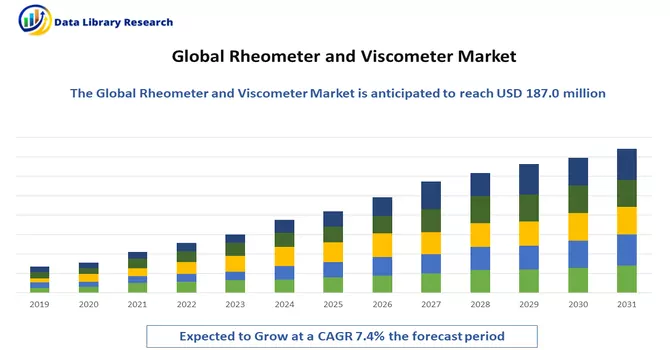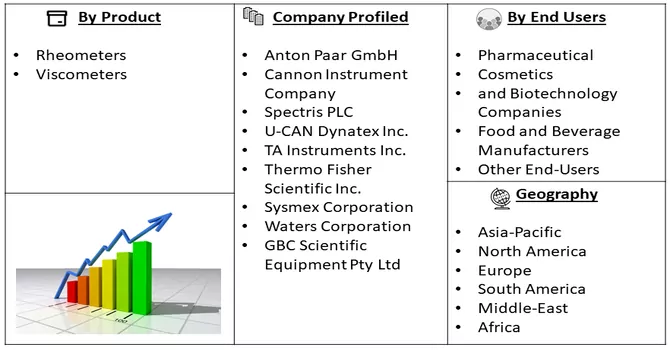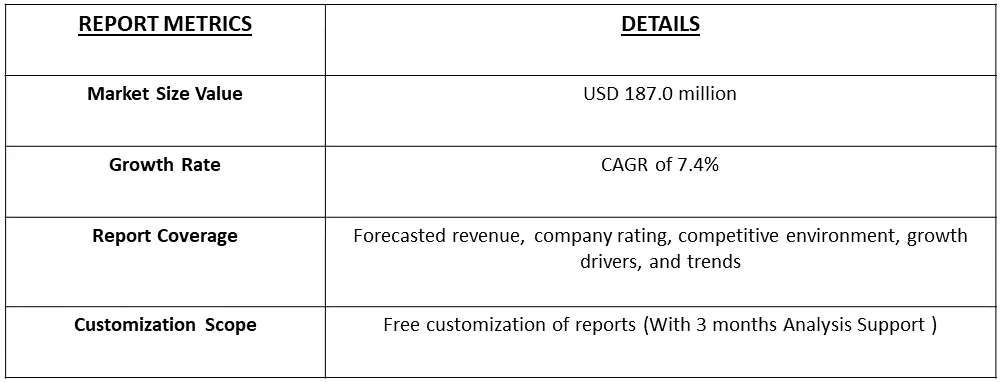The rheometer and viscometer market is currently valued at USD 187.0 million in 2023 and is anticipated to grow at a CAGR of 7.4% from 2023 to 2031.

Get Complete Analysis Of The Report - Download Free Sample PDF
A rheometer is an analytical device used to study the rheological properties of materials, which include how they flow, deform, and respond to applied forces. Rheometers measure key parameters such as viscosity, elasticity, and shear stress. They are crucial tools in various industries, including materials science, food and beverages, pharmaceuticals, and cosmetics, providing insights into the behaviour of complex fluids under different conditions. Viscometers, on the other hand, are instruments specifically focused on measuring viscosity, which is the resistance of a fluid to flow. They quantify the internal friction within a fluid as it moves or deforms. Viscometers are essential in determining the viscosity of liquids, helping industries ensure the desired consistency and quality of their products. These instruments find applications in fields like oil and gas, paints and coatings, and biomedical research.
The rheometer and viscometer market is fueled by multiple driving factors. Ongoing research and development activities in fields like materials science and pharmaceuticals propel the demand for these instruments, which play a crucial role in understanding and optimizing material properties. Industries such as oil and gas, where precise viscosity analysis is essential for drilling processes, contribute to market growth. Additionally, the expanding applications in quality control across diverse sectors, including food and beverages, cosmetics, and pharmaceuticals, further drive demand. The growing biotechnology and pharmaceutical sectors, along with the increasing need for advanced materials in automotive and aerospace industries, intensify the market's growth trajectory. The beauty and skincare industry's emphasis on product consistency, technological advancements in instrument capabilities, and compliance with stringent regulatory standards also play pivotal roles. Moreover, the awareness of the benefits of incorporating rheometers and viscometers in quality control processes, coupled with the industrialization in emerging markets, contributes to the widespread adoption of these instruments globally.
The rheometer and viscometer market is undergoing transformative trends that signal a shift towards enhanced efficiency, technological integration, and broader applications. Automation is emerging as a dominant trend, with a growing demand for automated systems that streamline testing processes and reduce manual errors. Advanced technologies like artificial intelligence and machine learning are increasingly being incorporated, elevating data analytics capabilities and providing more sophisticated insights. Portable and handheld devices are gaining popularity, offering flexibility in on-site measurements, particularly in industries where mobility is critical. User-friendly interfaces are becoming a focus, making these instruments more accessible to a diverse user base. The trend towards application-specific solutions is rising, with customized instruments tailored to meet the unique needs of industries such as cosmetics, pharmaceuticals, and materials science. In the pharmaceutical sector, rheometers and viscometers are gaining importance for drug formulation and quality control.
Market Segmentation: The Rheometer and Viscometer Market is Segmented by Product Type (Rheometers (Dynamic Rotational Rheometers, Torque Rotational Rheometers, Capillary Rheometers, and Other Rheometers), Viscometers (Rotational Viscometers, Process Viscometers, Capillary Viscometers, and Other Viscometers)), End-Users (Pharmaceutical, Cosmetics, and Biotechnology Companies, Food and Beverage Manufacturers, and Other End-Users) and Geography (North America, Europe, Asia-Pacific, Middle East and Africa, and South America). The report offers the value (in USD million) for the above segments.

For Detailed Market Segmentation - Download Free Sample PDF
Market Drivers:
Expansion of Petrochemical and Material Manufacturing Industries
The expansion of petrochemical and material manufacturing industries is a notable trend that has been shaping the industrial landscape. This growth is primarily driven by the increasing demand for a wide range of petrochemical products and materials across various sectors. Petrochemicals play a crucial role in the production of plastics, resins, adhesives, and other essential materials that are integral to industries such as packaging, automotive, construction, and consumer goods. The surge in infrastructure development, urbanization, and the automotive industry further propels the demand for materials manufactured through petrochemical processes. Moreover, advancements in technology and processes within the petrochemical industry contribute to increased efficiency and the development of innovative materials. As a result, the expansion of petrochemical and material manufacturing industries not only meets the growing market demands but also fosters economic development and technological progress. However, it's essential to manage the environmental impact and explore sustainable practices within these industries to ensure responsible growth in the long term.
Technological Advancements in Rheometers and Viscometers
Technological advancements in rheometers and viscometers have significantly enhanced their capabilities, providing more accurate and sophisticated measurements across various applications. One notable advancement is the integration of automation and computerization, allowing for precise control and real-time data analysis. This not only improves the efficiency of testing processes but also reduces human error, ensuring more reliable results. Furthermore, the incorporation of advanced sensor technologies has enabled greater sensitivity and responsiveness in rheometers and viscometers. This ensures the instruments can accurately capture subtle changes in material properties, making them invaluable in research and quality control applications. The rise of digitalization has led to user-friendly interfaces and enhanced connectivity features. Modern rheometers and viscometers often come equipped with touchscreens, intuitive software, and the ability to integrate with other laboratory equipment or data management systems. This facilitates ease of use, data interpretation, and seamless integration into larger experimental setups. Additionally, developments in materials and manufacturing have led to the creation of more durable and versatile components in rheometers and viscometers. This not only extends the lifespan of the instruments but also broadens their applicability to a wider range of materials and testing conditions.
The integration of advanced rheological models and algorithms, often supported by artificial intelligence (AI) and machine learning, has significantly improved the instruments' analytical capabilities. These technologies enable more sophisticated rheological analyses, aiding researchers and industries in gaining deeper insights into the complex behaviours of materials. Thus, technological advancements in rheometers and viscometers encompass automation, sensor technologies, digitalization, improved materials, and advanced analytical models. These innovations collectively contribute to the precision, efficiency, and versatility of these instruments, making them indispensable tools in various scientific, industrial, and research settings.
Market Restraints:
High Cost of the Viscometer and Rheometer
The elevated cost associated with viscometers and rheometers stands out as a potential factor that could exert an impact on the growth trajectory of these instruments. The substantial initial investment required for the procurement of high-quality viscometers and rheometers might pose a challenge, particularly for smaller businesses or industries operating within constrained budgets. The cost factor could act as a deterrent to widespread adoption, potentially limiting access for certain end-users. However, it's important to note that ongoing advancements in technology and market competition may contribute to cost reductions over time, making these instruments more accessible to a broader range of industries and facilitating their continued adoption despite the initial financial barrier.
The global impact of COVID-19 has extended to various sectors, including healthcare and the medical device industry, thereby influencing the rheometer and viscometer devices market. Government regulations and lockdown measures resulted in a substantial decrease in overall non-emergency medical treatments, leading to a reduced utilization of viscometers and rheometers. Despite emergency and outpatient services being available in cardiology departments, hospital visits experienced a significant decline in the initial months of the pandemic. An article published in May 2021, titled "The role of plasma viscosity testing in managing COVID-19 disease," highlighted the notable increase in plasma viscosity among COVID-19 patients. This elevated plasma viscosity emerged as a crucial, cost-effective, and accurate diagnostic test for identifying individuals positive for SARS-CoV-2. Consequently, the sales of rheometer and viscometer devices experienced an initial decline, but the market exhibited substantial growth in the subsequent months as healthcare services adapted to the evolving challenges posed by the pandemic.
Segmental Analysis:
Dynamic Rotational Rheometers is Expected to Witness Significant Growth Over the Forecast Period
Dynamic rotational rheometers stand at the forefront of materials characterization, offering a sophisticated suite of capabilities for the in-depth analysis of dynamic rheological properties. These instruments, crucial in research, quality control, and development across various industries, boast rotational functionality to meticulously study how materials respond to varying degrees of shear stress or strain. Operating in both oscillatory and rotational modes, dynamic rotational rheometers provide insights into dynamic moduli, phase angles, and flow behavior. Temperature control features facilitate investigations into the temperature-dependent properties of materials, essential for applications such as polymer processing, food science, and pharmaceuticals. Customizable geometry, including interchangeable options like concentric cylinders or cone and plate configurations, ensures adaptability for analyzing materials with diverse viscosities and rheological behaviors. Torque and force measurements during rotation are fundamental in characterizing a material's mechanical properties and deformation resistance.
Pharmaceutical, Cosmetics, and Biotechnology Companies is Expected to Witness a Significant Growth Over the Forecast Period
Pharmaceutical, cosmetics, and biotechnology companies leverage viscometers as essential tools in their research, development, and quality control processes. In the pharmaceutical sector, viscometers play a crucial role in characterizing the viscosity of drug formulations. This is vital for ensuring the proper flow properties of liquid medications, which, in turn, affects factors such as drug delivery and bioavailability. Additionally, viscometers contribute to the optimization of pharmaceutical processes, aiding in the development of consistent and high-quality drug formulations. In the cosmetics industry, viscometers are extensively used to assess the rheological properties of cosmetic products, including lotions, creams, and gels. These instruments help companies maintain the desired consistency and texture of cosmetic formulations, ensuring a positive sensory experience for consumers. Viscometers assist in achieving the optimal viscosity for easy application, absorption, and overall product performance. Biotechnology companies also find viscometers valuable in various applications. In bioprocessing, viscometers are employed to monitor and control the viscosity of cell cultures and fermentation broths. Maintaining precise viscosity levels is critical for the efficient production of biopharmaceuticals and other biotechnological products. Viscometers contribute to process optimization, ensuring consistent product quality and yield. Furthermore, viscometers aid in quality control across these industries by enabling the detection of deviations in viscosity that may indicate formulation irregularities or process variations. The ability to perform rapid and accurate viscosity measurements is especially beneficial in ensuring compliance with regulatory standards and meeting product specifications. Thus, viscometers are indispensable instruments for pharmaceutical, cosmetics, and biotechnology companies. Their versatile applications, ranging from formulation development to quality control, contribute to the overall efficiency, consistency, and success of processes within these industries.
North America is Expected to Witness a Significant Growth Over the Forecast Period
North America is poised to command a substantial market share in the global rheometer and viscometer market, propelled by an increasing volume of disease diagnostic procedures centered around viscosity and rheology analysis. The region benefits from technological advancements, a heightened consumption of packaged food, and the presence of major industry players. Notably, the market is witnessing growth spurred by new product launches, exemplified by RheoSense, Inc.'s introduction of VROC initium one plus in August 2020, an automatic viscometer renowned for its high-precision viscosity measurements. The imperative for food safety and quality checks is accentuated by the alarming statistic from the United States Food and Drug Administration (USFDA), reporting approximately 48 million cases of foodborne illnesses annually, emphasizing the need for advanced rheometer and viscometer technologies in the region. The robust healthcare infrastructure, augmented healthcare expenditure, and increasing awareness of such diagnostic tools further contribute to the market's expansion. Moreover, the burgeoning demand in sectors like construction, petrochemicals, and industrial oil and lubricants is anticipated to further stimulate growth. TA Instruments' introduction of the high-performance rheometer, the discovery hybrid rheometer HR 30, in March 2020 underscores the commitment to advancing rheological capabilities. With a sensitivity five times higher than previous versions, it enhances the versatility of obtaining accurate rheological data for users of all experience levels. The confluence of these factors positions North America for significant growth throughout the forecast period.

Get Complete Analysis Of The Report - Download Free Sample PDF
The market for rheometers and viscometers exhibits a fragmented structure characterized by the participation of a limited number of companies operating on both a global and regional scale. The competitive landscape involves the scrutiny of several international and local companies that contribute to the market shares within this sector. The presence of a diverse range of players, both on a global and local level, adds to the competitive dynamics of the rheometer and viscometer market. This diverse participation underscores the multifaceted nature of the industry, with each player contributing to the overall market share through their specific expertise, product offerings, and regional influence. Some of the market players are:
Recent Developments:
1) In April 2022, Cambridge Viscosity introduced the ViscoLab PVT+, a crucial instrument designed to assist operators in comprehending the behaviour of liquids under extreme conditions. The ViscoLab PVT+ is specifically engineered to offer real-time data, empowering operators with valuable insights and aiding in informed decision-making to enhance operational processes.
2) In March 2022, AMETEK Brookfield unveiled its latest RSX Rheometer. The RSX stands out as an advanced rheometer instrument equipped with a touch screen interface. It facilitates controlled shear rate (rpm) and controlled shear stress (torque) modes, enabling sophisticated rheological analysis. This innovative rheometer provides a comprehensive solution for analyzing the flow and deformation characteristics of materials, catering to a diverse range of applications in research and industry.
Q1. What is the current Rheometer and Viscometer Market size?
The rheometer and viscometer market is currently valued at USD 187.0 million.
Q2. What is the Growth Rate of the Rheometer and Viscometer Market?
Rheometer and Viscometer Market is anticipated to grow at a CAGR of 7.4% over the forecast period.
Q3. What are the Growth Drivers of the Rheometer and Viscometer Market?
Expansion of Petrochemical and Material Manufacturing Industries and Technological Advancements in Rheometers and Viscometers are the Growth Drivers of the Rheometer and Viscometer Market.
Q4. Which region has the largest share of the Rheometer and Viscometer Market? What are the largest region's market size and growth rate?
North America has the largest share of the market. For detailed insights on the largest region's market size and growth rate request a sample here.
Data Library Research are conducted by industry experts who offer insight on industry structure, market segmentations technology assessment and competitive landscape (CL), and penetration, as well as on emerging trends. Their analysis is based on primary interviews (~ 80%) and secondary research (~ 20%) as well as years of professional expertise in their respective industries. Adding to this, by analysing historical trends and current market positions, our analysts predict where the market will be headed for the next five years. Furthermore, the varying trends of segment & categories geographically presented are also studied and the estimated based on the primary & secondary research.
In this particular report from the supply side Data Library Research has conducted primary surveys (interviews) with the key level executives (VP, CEO’s, Marketing Director, Business Development Manager and SOFT) of the companies that active & prominent as well as the midsized organization
FIGURE 1: DLR RESEARH PROCESS

Extensive primary research was conducted to gain a deeper insight of the market and industry performance. The analysis is based on both primary and secondary research as well as years of professional expertise in the respective industries.
In addition to analysing current and historical trends, our analysts predict where the market is headed over the next five years.
It varies by segment for these categories geographically presented in the list of market tables. Speaking about this particular report we have conducted primary surveys (interviews) with the key level executives (VP, CEO’s, Marketing Director, Business Development Manager and many more) of the major players active in the market.
Secondary ResearchSecondary research was mainly used to collect and identify information useful for the extensive, technical, market-oriented, and Friend’s study of the Global Extra Neutral Alcohol. It was also used to obtain key information about major players, market classification and segmentation according to the industry trends, geographical markets, and developments related to the market and technology perspectives. For this study, analysts have gathered information from various credible sources, such as annual reports, sec filings, journals, white papers, SOFT presentations, and company web sites.
Market Size EstimationBoth, top-down and bottom-up approaches were used to estimate and validate the size of the Global market and to estimate the size of various other dependent submarkets in the overall Extra Neutral Alcohol. The key players in the market were identified through secondary research and their market contributions in the respective geographies were determined through primary and secondary research.
Forecast Model
